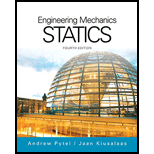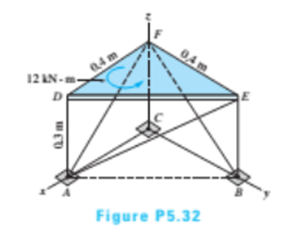
International Edition---engineering Mechanics: Statics, 4th Edition
4th Edition
ISBN: 9781305501607
Author: Andrew Pytel And Jaan Kiusalaas
Publisher: CENGAGE L
expand_more
expand_more
format_list_bulleted
Concept explainers
Textbook Question
Chapter 5, Problem 5.32P
Calculate the reaction at D for the structure described in Prob. 5.11.

Expert Solution & Answer
Want to see the full answer?
Check out a sample textbook solution
Students have asked these similar questions
4. An impeller rotating at 1150 rpm has the following data: b, = 1 ¼ in., b2 = ¾ in., d, = 7 in., d2 =
15 in., B1 = 18", B2 = 20°, cross-sectional area A = Db if vane thickness is neglected. Assuming radial inlet flow, determine the theoretical
capacity in gpm
head in ft
horsepower
5. If the impeller in Problem (4) develops an actual head of 82 ft and delivers 850 gpm at the point of maximum efficiency and requires 22 BHP. Determine
overall pump efficiency
virtual velocities V2 and W2
(30 pts) Problem 1
A thin uniform rod of mass m and length 2r rests in a smooth hemispherical bowl of radius r. A
moment M
mgr
4
is applied to the rod. Assume that the bowl is fixed and its rim is in the
horizontal plane.
HINT: It will help you to find the length l of that portion of the rod that remains outside the
bowl.
M
2r
a) How many degrees of freedom does this system have?
b) Write an equation for the virtual work in terms of the angle 0 and the motion of the
center of mass (TF)
c) Derive an equation for the variation in the position of the center of mass (i.e., Sŕƒ)
a. HINT: Use the center of the bowl as the coordinate system origin for the problem.
d) In the case of no applied moment (i.e., M 0), derive an equation that can be used to
solve for the equilibrium angle of the rod. DO NOT solve the equation
e) In the case of an applied moment (i.e., M
=
mgr
= -) derive an equation that can be used to
4
solve for the equilibrium angle of the rod. DO NOT solve the equation.
f) Can…
Please show all work step by step
Chapter 5 Solutions
International Edition---engineering Mechanics: Statics, 4th Edition
Ch. 5 - Bar AB of negligible weight is supported by a...Ch. 5 - Draw the FBD for the bar described in Prob. 5.1 if...Ch. 5 - The space truss ABCD in the shape of a tetrahedron...Ch. 5 - Draw the FBD of the portion BCD of the space truss...Ch. 5 - The homogeneous plate of weight W is supported by...Ch. 5 - The bar ABCD of negligible weight is supported by...Ch. 5 - The shaft-pulley assembly is supported by the...Ch. 5 - The 60-lb homogeneous door is supported by hinges...Ch. 5 - Draw the FBD for bar BCD. The connections at A and...Ch. 5 - The homogeneous 360-lb plate with a rectangular...
Ch. 5 - The L-shaped rod, supported by slider bearings at...Ch. 5 - The homogeneous 240-lb bar is supported by a rough...Ch. 5 - In Sample Problem 5.4, determine the tension TAC...Ch. 5 - In Sample Problem 5.5, compute the tension TAD...Ch. 5 - In Sample Problem 5.5, determine Oy with one...Ch. 5 - Determine the tension TB in Sample Problem 5.6...Ch. 5 - Compute the tension TAE in Sample Problem 5.7...Ch. 5 - The 80-lb homogeneous plate is suspended from four...Ch. 5 - The three bars are welded together to form a rigid...Ch. 5 - The compound bar is supported by a thrust bearing...Ch. 5 - The homogeneous 20-kg door is held in the...Ch. 5 - The light boom AB is attached to the vertical wall...Ch. 5 - The homogeneous 80-kg sign is suspended from a...Ch. 5 - The bar ABC is supported by a ball-and-socket at A...Ch. 5 - Determine the forces in members PAE,PAF, and PBG...Ch. 5 - The figure shows the FBD of a portion of the space...Ch. 5 - Calculate all forces acting on the bar AB...Ch. 5 - Determine the forces in members AD, BD, and CD of...Ch. 5 - Find the tension in cable BE that supports the bar...Ch. 5 - For the structure in Prob. 5.9, determine the...Ch. 5 - Calculate the reaction at D for the structure...Ch. 5 - Calculate the reaction at D for the structure...Ch. 5 - Determine the tension in each of the three ropes...Ch. 5 - Using only one equilibrium equation, compute the...Ch. 5 - The homogeneous 25-kg bar AB is supported by a...Ch. 5 - The shaft AB is supported by a thrust bearing at A...Ch. 5 - The bar ABCD has a built-in support at A....Ch. 5 - The total weight of the L-shaped beam of constant...Ch. 5 - The bent rod of negligible weight is supported by...Ch. 5 - A 120-lb weight is attached to the cable that is...Ch. 5 - Calculate the force in cable CD and the reaction...Ch. 5 - The 350-lb homogeneous plate has the shape of an...Ch. 5 - The bent rod ABCD is supported by a...Ch. 5 - A hoist is formed by connecting bars BD and BE to...Ch. 5 - The crank arm OD of the winch is connected by a...Ch. 5 - The 80-lb homogeneous plate is supported by a...Ch. 5 - The frame is built into the wall at D and G. The...Ch. 5 - The bent bar of negligible weight is supported by...Ch. 5 - Determine the reactions at ball-and-socket joints...Ch. 5 - The 180-lb homogeneous bar is supported by a...Ch. 5 - The bent rod is supported by a ball-and-socket...Ch. 5 - Find the maximum load P that can be supported by...Ch. 5 - The vertical mast OA, which weighs 1.5 kN, is...Ch. 5 - The homogeneous bar AB weighs 50-lb. End B leans...Ch. 5 - The 500-kg crate is supported by the three cables....Ch. 5 - The uniform bars AB and BC each weigh 4 lb/ft....Ch. 5 - The rigid body of negligible weight is supported...Ch. 5 - The homogeneous 860-kg bar AB is supported by a...Ch. 5 - The triangular plate is supported by three...Ch. 5 - The connections at the ends of bars AB and BC arc...Ch. 5 - The bar AEB is supported by a ball-and-socket...Ch. 5 - The shaft is supported by a thrust bearing at A...
Knowledge Booster
Learn more about
Need a deep-dive on the concept behind this application? Look no further. Learn more about this topic, mechanical-engineering and related others by exploring similar questions and additional content below.Similar questions
- Copyright 2013 Pearson Education, publishing as Prentice Hall 2. Determine the force that the jaws J of the metal cutters exert on the smooth cable C if 100-N forces are applied to the handles. The jaws are pinned at E and A, and D and B. There is also a pin at F. E 400 mm 15° D B 30 mm² 80 mm/ 20 mm 15° $15° 20 mm 400 mm 15° 100 N 100 N 15°arrow_forwardDraw for it make a match which directionarrow_forwardQ.1) Block A is connected to block B by a pulley system as shown. The weights of blocks A and B are 100 lbs and 70 lbs, respectively. Assume negligible friction between the rope and all pulleys as well as between block B and the incline and neglect the mass of all pulleys and cables. Determine the angle 0 required to keep the system in equilibrium. (At least two FBDs must be drawn for full credit) B Ꮎ 000arrow_forward
- pls solvearrow_forward+1. 0,63 fin r= 0.051 P The stepped rod in sketch is subjected to a tensile force that varies between 4000 and 7000 lb. The rod has a machined surface finish everywhere except the shoulder area, where a grinding operation has been performed to improve the fatigue resistance of the rod. Using a 99% probability of survival, determine the safety factor for infinite life if the rod is made of AISI 1080 steel, quenched and tempered at 800°c Use the Goodman line. Does the part fail at the fillet? Explainarrow_forwardSolve this problem and show all of the workarrow_forward
- I need drawing solution,draw each one by one no Aiarrow_forwardQu. 17 Compute linear density values for [100] for silver (Ag). Express your answer in nm''. . Round off the answer to three significant figures. Qu. 18 Compute linear density value for [111] direction for silver (Ag). Express your answer in nm'. Round off the answer to three significant figures. Qu. 19 Compute planar density value for (100) plane for chromium (Cr). Express your answer in nm?. Round off the answer to two significant figures. Qu. 20 Compute planar density value for (110) plane for chromium (Cr). Express your answer in nm ≥ to four significant figures. show all work please in material engineeringarrow_forward3-142arrow_forward
arrow_back_ios
SEE MORE QUESTIONS
arrow_forward_ios
Recommended textbooks for you
 International Edition---engineering Mechanics: St...Mechanical EngineeringISBN:9781305501607Author:Andrew Pytel And Jaan KiusalaasPublisher:CENGAGE L
International Edition---engineering Mechanics: St...Mechanical EngineeringISBN:9781305501607Author:Andrew Pytel And Jaan KiusalaasPublisher:CENGAGE L

International Edition---engineering Mechanics: St...
Mechanical Engineering
ISBN:9781305501607
Author:Andrew Pytel And Jaan Kiusalaas
Publisher:CENGAGE L
Types Of loads - Engineering Mechanics | Abhishek Explained; Author: Prime Course;https://www.youtube.com/watch?v=4JVoL9wb5yM;License: Standard YouTube License, CC-BY